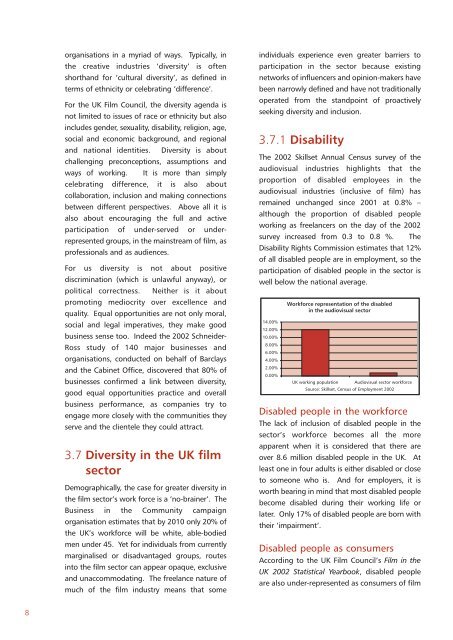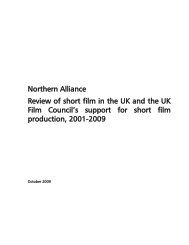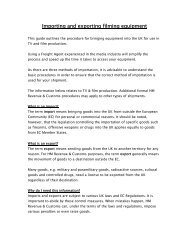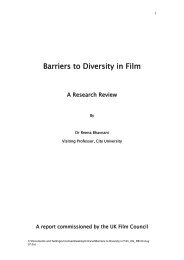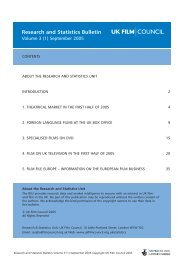Success through diversity and inclusion - BFI - British Film Institute
Success through diversity and inclusion - BFI - British Film Institute
Success through diversity and inclusion - BFI - British Film Institute
Create successful ePaper yourself
Turn your PDF publications into a flip-book with our unique Google optimized e-Paper software.
8<br />
organisations in a myriad of ways. Typically, in<br />
the creative industries ‘<strong>diversity</strong>’ is often<br />
shorth<strong>and</strong> for ‘cultural <strong>diversity</strong>’, as defined in<br />
terms of ethnicity or celebrating ‘difference’.<br />
For the UK <strong>Film</strong> Council, the <strong>diversity</strong> agenda is<br />
not limited to issues of race or ethnicity but also<br />
includes gender, sexuality, disability, religion, age,<br />
social <strong>and</strong> economic background, <strong>and</strong> regional<br />
<strong>and</strong> national identities. Diversity is about<br />
challenging preconceptions, assumptions <strong>and</strong><br />
ways of working. It is more than simply<br />
celebrating difference, it is also about<br />
collaboration, <strong>inclusion</strong> <strong>and</strong> making connections<br />
between different perspectives. Above all it is<br />
also about encouraging the full <strong>and</strong> active<br />
participation of under-served or underrepresented<br />
groups, in the mainstream of film, as<br />
professionals <strong>and</strong> as audiences.<br />
For us <strong>diversity</strong> is not about positive<br />
discrimination (which is unlawful anyway), or<br />
political correctness. Neither is it about<br />
promoting mediocrity over excellence <strong>and</strong><br />
quality. Equal opportunities are not only moral,<br />
social <strong>and</strong> legal imperatives, they make good<br />
business sense too. Indeed the 2002 Schneider-<br />
Ross study of 140 major businesses <strong>and</strong><br />
organisations, conducted on behalf of Barclays<br />
<strong>and</strong> the Cabinet Office, discovered that 80% of<br />
businesses confirmed a link between <strong>diversity</strong>,<br />
good equal opportunities practice <strong>and</strong> overall<br />
business performance, as companies try to<br />
engage more closely with the communities they<br />
serve <strong>and</strong> the clientele they could attract.<br />
3.7 Diversity in the UK film<br />
sector<br />
Demographically, the case for greater <strong>diversity</strong> in<br />
the film sector’s work force is a ‘no-brainer’. The<br />
Business in the Community campaign<br />
organisation estimates that by 2010 only 20% of<br />
the UK’s workforce will be white, able-bodied<br />
men under 45. Yet for individuals from currently<br />
marginalised or disadvantaged groups, routes<br />
into the film sector can appear opaque, exclusive<br />
<strong>and</strong> unaccommodating. The freelance nature of<br />
much of the film industry means that some<br />
individuals experience even greater barriers to<br />
participation in the sector because existing<br />
networks of influencers <strong>and</strong> opinion-makers have<br />
been narrowly defined <strong>and</strong> have not traditionally<br />
operated from the st<strong>and</strong>point of proactively<br />
seeking <strong>diversity</strong> <strong>and</strong> <strong>inclusion</strong>.<br />
3.7.1 Disability<br />
The 2002 Skillset Annual Census survey of the<br />
audiovisual industries highlights that the<br />
proportion of disabled employees in the<br />
audiovisual industries (inclusive of film) has<br />
remained unchanged since 2001 at 0.8% –<br />
although the proportion of disabled people<br />
working as freelancers on the day of the 2002<br />
survey increased from 0.3 to 0.8 %. The<br />
Disability Rights Commission estimates that 12%<br />
of all disabled people are in employment, so the<br />
participation of disabled people in the sector is<br />
well below the national average.<br />
14.00%<br />
12.00%<br />
10.00%<br />
8.00%<br />
6.00%<br />
4.00%<br />
2.00%<br />
0.00%<br />
Workforce representation of the disabled<br />
in the audiovisual sector<br />
UK working population Audiovisual sector workforce<br />
Source: Skillset, Census of Employment 2002<br />
Disabled people in the workforce<br />
The lack of <strong>inclusion</strong> of disabled people in the<br />
sector’s workforce becomes all the more<br />
apparent when it is considered that there are<br />
over 8.6 million disabled people in the UK. At<br />
least one in four adults is either disabled or close<br />
to someone who is. And for employers, it is<br />
worth bearing in mind that most disabled people<br />
become disabled during their working life or<br />
later. Only 17% of disabled people are born with<br />
their ‘impairment’.<br />
Disabled people as consumers<br />
According to the UK <strong>Film</strong> Council’s <strong>Film</strong> in the<br />
UK 2002 Statistical Yearbook, disabled people<br />
are also under-represented as consumers of film


